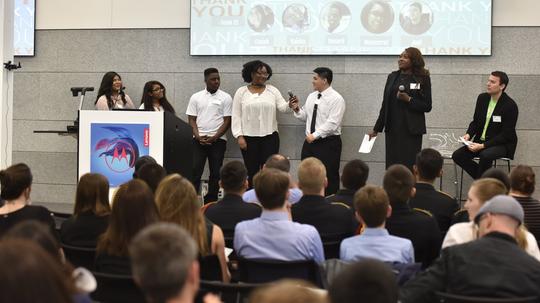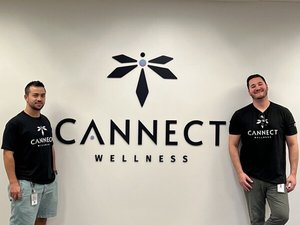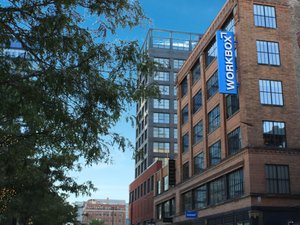
A filtration attachment that detects the amount of lead in drinking water.
A wearable that is powered by solar energy and can charge your phone on the go.
A redesigned granola bar with all the healthy ingredients of a salad.
A social media app designed for cancer patients to find community and support.
These are just four of the twenty-six solutions offered by some of the state’s best and brightest high school students to real-world challenges, as part of the Chicago-based Illinois Science and Technology Institute’s (ISTI) statewide STEM Challenges.
While problem-based learning is not a new concept, ISTI’s program is unique in the sense that the challenges presented to the students come directly from real problems faced by academia and industry. Students have access to mentors for feedback on research plans and prototypes, both via in-person check-ins as well as online engagement on an invitation-only Mentor Matching Engine platform.
Close to two hundred students (selected from 1,200 who experienced the program) gathered at Motorola Mobility’s headquarters in the Merchandise Mart on Thursday to present their solutions in front of their peers, teachers and industry mentors.
Karen Freese and Dena Strehlow, both from Decatur-based Archer Daniels Midland Company (ADM), recounted the positive experience of working with local Decatur Public School students on a challenge to redesign their favorite snack with healthier ingredients.
“It isn’t often intuitive for students to see how closely integrated technology is in food production -- and just how many careers can be pursued in this field," Strehlow said in an interview. "Through this program, we invited students into our food innovation lab, with the goal of providing insight into the food development process, complete with business ideas of packaging and marketing."
Learning how to work in teams, think critically, apply thoughtful iteration, and embrace failure, students worked under the mentorship of scientists and engineers over five months. Olayinka Adekola, a sophomore at ITW David Speer Academy, worked on a smart energy usage challenged posed by Illinois State University's Center for Renewable Energy.
“I appreciated not being given all the answers at the outset, along with the opportunity to take risks and have a real impact on my community,” she said. She is considering pursuing a career in computer engineering and software design in the future.
Educators are also given the opportunity to collaborate with the ISTI team and industry mentors to formally structure the challenges, and ways to recognize students participating in the program. Alex Larson, STEM teacher at Palatine High School, has worked with ISTI for four years. “I’ve seen a significant shift in how my students approach problems -- feedback from industry makes them feel their ideas are valued, instilling a sense of confidence,” he said.
Here’s a look at how Illinois students rose to meet the STEM challenges:
Takeda Pharmaceuticals asked students to find ways to increase medication adherence, which the FDA estimates to be a real problem. Students from Evanston Township High School addressed depression in teenagers from racial minorities, by launching a community campaign to get more diverse counselors into the school. Phoenix Military Academy created a robot that dispenses medication, and Solorio Academy created a ‘Medimoji’ app blending emojis and medical advice. Prospect High School created a patch that delivers depression medication and connects to a smart watch to monitor dosage and adherence.
Loyola University's Center for Science and Math Education's challengeRogers Park neighbor Senn High School inspired a rooftop windmill concept for their school to harness wind energy. Students realized their shortcomings in not being able to collect data from multidirectional wind on different days.
Northrop Grumman’s challenge to Palatine and Oak Park & River Forest High Schools inspired a remotely operated, weight efficient, self-powered, solar heat-shield defense solution that can deploy a self-supporting structure.
Illinois State University's Center for Renewable Energy asked students to innovate ways to manage everyday energy/water usage. Washington Community High School’s solution saved upto $30,000 in energy and water costs at their school. ITW David Speer created a model of a DC microgrid to power two schools. Downers Grove South High School pitched a solar-powered wearable that can power your phone on the go. Williamsfield High School, in a theatrical and energetic performance, demonstrated a shower head capable of sensing water temperature and time.
AbbVie Foundation asked students to design a solution improving lives of cancer patients. North Chicago Community High School created a social media app for patients with cancer connecting them to community and resources.
Motorola Mobility asked students to apply mobile technology towards community issues. Von Steuben Metropolitan Science Center created “Never Lost Wallet”, a wallet that can be tracked via a GPS sensor if lost. Gwendolyn Brooks College Prep created ‘Money Bandz’, wearables wherein parents can pre-load money for their kids and which work similar to Apple Pay.
Baxter International asked students to explore home healthcare technologies for dialysis and parenteral nutrition. Lindblom Math and Science Academy created a secure social network mobile app and web solution to home dialysis. Instituto Health Sciences Career Academy realized that seeing blood/other liquids through clear tubing was upsetting to parental nutrition patients, so they designed and collected a survey of ~200 students to research psychology of color and designed tinted tubing using calming colors. Muchin College Prep created an early detection system for peritonitis integrating with Baxter's existing dialysis system.
Microsoft asked students to use IoT to create a better community. Students at Lake View High School recommended "Helping Candy Cam", a camera to prevent abuse of elders by detecting body temperature and distress. Corliss High School’s IoT solution helps first responders address hypothermia in homeless populations.
Motorola Solutions asked students to use tech to help make their communities feel safe. Chicago Vocational Career Academy showed off a water filtration attachment that can detect amount of lead in the water, transfers real-time information to an app and alerts residents to a possibly critical situation.
State Farm asked students to identify a community issue relevant to the insurance or IT space. Bloomington High School suggested use of drones for insurance adjustment purposes, Normal Community High School devised a smart alert system to detect household flooding, and Normal West High School addressed insurance for injuries among 16-25 year old drivers using a windshield attachment that detects threats.
Horizon Pharma challenged Highland park High School to develop new ways to deliver medication for urea cycle disorder and the students created a new syringe that dispenses medication.
ADM challenged students to take their favorite snack bar and make it healthier. MacArthur High School created soy- and gluten-free cookies with heat sealed packaging for freshness, with half the calories and twice the protein as their competitor. Eisenhower High School created a 'salad bar' -- a salad in a granola bar type format.
Note: The writer is co-employed by ISTI and Chicago Inno.








